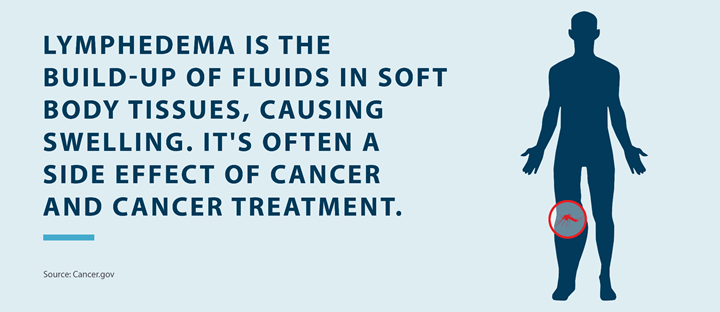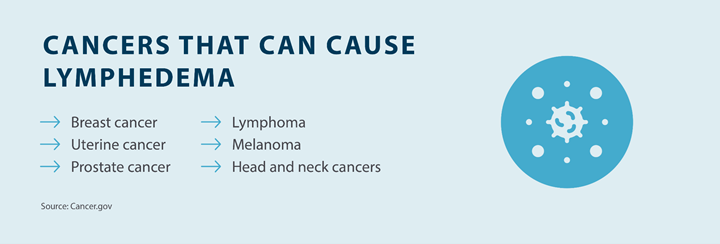Lymphedema and Weight Loss
Living with lymphedema while trying to manage your weight can feel overwhelming, but understanding the connection between lymphedema and weight loss can help you develop effective strategies for both conditions.
Read More

Lymphedema is a condition that can occur when a part of the lymph system, such as a vessel or node, is blocked. This blockage then causes a build-up of fluid that can lead to pain and swelling, typically in a limb. Lymphedema is fairly common in cancer patients and can be a result of cancer treatment. Keep reading to learn more about lymphedema and cancer, whether cancer can cause lymphedema, and how to prevent this medical condition.
Your body is made up of several different systems, each of which has a specific job to do. Your lymph system consists of lymph nodes, vessels, and fluid which is carried throughout the body and filtered through the nodes. The lymphatic system plays an important role in the body’s immune response to help fight off infections and maintain normal fluid balance. However, when lymph nodes or vessels become damaged or blocked, the fluid can build up, causing localized edema or swelling.
Lymphedema is a chronic condition that results in swelling that occurs most often in your arms and legs, but can occur anywhere in the body. As excess fluid accumulates in your body, it can lead to chronic swelling, pain, and discomfort if left untreated. If not managed daily, lymphedema becomes a progressive condition.
There are several causes of lymphedema, with treatments for cancer being one of the most common. Cancer survivors should be educated on the risk of lymphedema when going through treatment for their disease. This is why it’s important to understand the correlation between lymphedema and cancer as a cancer survivor.

Can cancer cause lymphedema? The short answer is yes. However, lymphedema isn’t typically caused by cancer itself, but by the treatment that doctors use to remove cancer from your body. Because lymphedema is caused by damage to the lymphatic system, damage to lymph nodes or lymph vessels can lead to lymphedema.
During surgery to remove cancer, surgeons may remove lymph nodes to test if they are positive for cancer. Removing these positive lymph nodes is necessary to help prevent the spread of cancer. While not every person undergoing treatment for cancer will develop lymphedema, it is the most common side effect.
In some cases, lymphedema in cancer patients can be caused by radiation therapy that’s used to kill and slow the growth of cancerous cells. Radiation is very hard on your body in several ways, and that can include damage to your lymph nodes and vessels. As radiation damages these cells and causes a build-up of scar tissue, your lymph system may be obstructed at some point.
Because lymphedema and cancer are often closely associated, you may wonder if lymphedema can be a sign of cancer. While lymphedema is often caused by cancer or cancer treatment, severe lymphedema that goes untreated can, in rare cases, develop into a type of soft tissue cancer in the lymphatic system, called lymphangiosarcoma.
In most cases, lymphedema occurs from scar tissue and the destruction of lymph nodes and vessels due to radiation or the removal of lymph nodes through surgery. Occasionally, the cancer tumor itself can obstruct the flow of the lymphatics, depending on the location and size of the tumor.
Most patients who are diagnosed with lymphedema as a result of cancer are diagnosed with it after they’ve received treatment, such as radiation or a surgical procedure. Of course, it’s always best to visit a doctor to review your symptoms for a proper diagnosis and to determine the best course of treatment.
If you’ve been diagnosed with lymphedema after cancer treatment, one of the first steps to take is to educate yourself and learn how to manage symptoms. Lymphedema is chronic and causes pain and discomfort, which can impact your quality of life. Fortunately, there are several at-home management tools that don’t involve surgery or medications.
At Tactile Medical, we have several lymphedema treatment and management solutions that can help alleviate the symptoms associated with lymphedema right at home. For patients experiencing lymphedema after cancer, the Flexitouch Plus system is designed to stimulate your lymphatic system to move excess fluids throughout your limbs to reduce swelling. This device provides a gentle and safe treatment that can be prescribed by your doctor for at-home management. With lower body, upper body, and head and neck lymphedema treatment, you can find a device to relieve pain, discomfort, and swelling in your affected area.
In addition to lymphedema pumps and compression garments, there are other ways you can manage your lymphedema at home. When consulting with a lymphedema specialist, they may recommend a technique referred to as manual lymphatic drainage (MLD) to redirect fluid from swollen areas to healthier areas to drain normally. Complete Decongestive Therapy also includes education on the importance of skin scare and exercise to manage symptoms.
If you’ve been diagnosed with lymphedema after cancer, consult with your doctor and a lymphedema specialist. They can provide management and treatment solutions, as well as prescribe at-home lymphedema therapy, such as lymphedema pumps and compression garments.
While there are several types of cancer with treatments that may cause lymphedema, such as those that require lymph node removal, certain types of cancer come with a higher risk of lymphedema.
Treatment for breast cancer is one of the most common causes of lymphedema in the arms, chest, or trunk because the removal of cancerous tissue often requires the removal of the lymph nodes that are located in your underarms. When it comes to uterine cancer, prostate cancer, vulvar cancer, and ovarian cancer, lymphedema in the lower part of the body including the legs, buttock, and genital region can occur.

Lymphoma is a type of cancer that specifically affects the lymph system and may lead to lymphedema.
According to one study, about 42% of breast cancer patients developed lymphedema, where most were mild cases. Another study examined the prevalence of lymphedema in patients who experienced other types of cancer. You can find all the data from this study below:
Lymphedema is underdiagnosed in cancer survivors. If you’re experiencing any chronic swelling symptoms associated with lymphedema after cancer, consult with your doctor.
Lymphedema can lead to pain, swelling, loss of range of motion, and even skin infections, so it’s important to get a diagnosis from a doctor and find ways to manage your symptoms as soon as possible.
The good news is, medical technology is making it easier to manage lymphedema. Tactile Medical’s Flexitouch Plus system provides an easy way to stimulate your lymph system to encourage an increase in flow of lymph fluids and a reduction in pain and swelling. Plus, this system is available for your lower body, upper body, and even your head and neck. If you’re having trouble managing your lymphedema, Tactile Medical’s Flexitouch Plus system can help.
Living with lymphedema while trying to manage your weight can feel overwhelming, but understanding the connection between lymphedema and weight loss can help you develop effective strategies for both conditions.
Read More
Stage three lymphedema is the most advanced stage of this chronic condition. In this stage, the affected body part might display one or more symptoms, such as significant swelling, alterations in the skin, or recurring episodes of infection. While this stage can be challenging to manage, understanding your condition and...
Read More
When the lymphatic system becomes compromised, fluid buildup can lead to stage 1 lymphedema, a condition marked by mild but noticeable swelling in affected areas. This initial stage is a crucial window for intervention, as proper treatment can prevent progression to more severe stages. Knowing the signs, causes, and treatment...
Read More
Living with stage 2 lymphedema brings unique challenges, but understanding your condition is the first step toward effectively managing it. While this stage marks a point where the condition becomes irreversible, there are many ways to maintain your quality of life and prevent symptoms from progressing. Keep reading to explore...
Read More
Call us at 1.800.575.1900